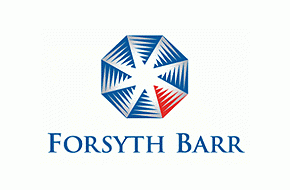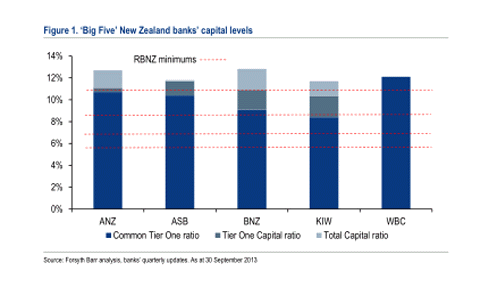
Content supplied by Forsyth Barr
The following is a summary of the key events impacting fixed income markets over the past week.
As we approach the first Official Cash Rate (OCR) review of 2014, stronger than expected GDP and inflation figures are pushing some to call for a hike in the OCR as early as next week.
Inflation stronger than RBNZ forecast
The inflation figures for the December 2013 quarter were released today, mounting further pressure on the Reserve Bank of New Zealand (RBNZ) to lift the OCR next week. The consumers price index (CPI) rose +0.1% in the quarter or 1.6% for the year. This is significantly stronger than the RBNZ had forecast in its Monetary Policy Statement back in December of -0.2% and 1.4%.
The RBNZ has stated many times that it intends to maintain future inflation levels around the mid-point (2.0%) and hence the room to manoeuvre is now limited. The impact on the markets has been swift with the NZD strengthening against all the major currencies.
Short-end of the curves reacts
Along with the NZD, the short-end of the swap curve moved higher in anticipation of a possible early move by the RBNZ. We have highlighted previously about the shape of the yield curve and how a tightening bias from the RBNZ will see the yield curve flatten over 2014.
In response to the CPI data, the yield curve flattened with the one-year swap rate +6bp and the 10-year swap rate rising only +1bp. The markets have moved more aggressively towards a rise in the OCR at next week’s OCR review with currently a 65% chance now priced in. We would still expect a rate rise at a Monetary Policy Statement meeting, which does not occur until March, however nothing can be ruled out as economic data continues to surprise on the upside, easily beating the RBNZ’s most recent forecasts.
US inflation on the rise also
The US CPI rose +0.3% in December, the biggest gain in six months pushing the annual inflation rate to 1.5%. Whilst an improvement, annual CPI of 1.5% is still well short of the Fed’s target of 2.5%. A recovery in the US maybe, but a slow one at that with less than linear tapering likely from the Fed.
Bank regulators continuing to water down regulations
Early last week the Basel Committee for Banking Supervision revised its definition of the proposed leverage ratio. The Committee, which is made up from banking regulators from around the world, softened their stance allowing banks to ‘offset’ certain exposures.
The leverage ratio measures capital held by a bank to the total size of a bank’s assets, so in effect the ‘dulling down’ of the ratio will lead to higher capital ratios. In New Zealand the RBNZ decided against adopting the leverage component of the Basel framework.
US banks hit by bond trading revenue decline
QEIII has not helped the major banks in the US with bond market trading impacting earnings as Goldman Sachs, Citigroup and Deutsche Bank all confirmed in recent days. With the Fed operating in the market and so much conjecture around the tapering timetable, the usual large profits from bond trading disappeared, coupled with a less than rosy outlook for 2014.
Transitional timetable now in play
As the new year rolled around so did the start of the Reserve Bank of New Zealand’s Basel III transitional timetable for non-qualifying capital securities. As a consequence all of the existing batch of capital securities undertook a 20% ‘haircut’ on 1 January 2014.
Another development that occurred on 1 January 2014 is the introduction of the Capital Conservation Buffer (CCB). With the inclusion of the CCB, banks total capital ratio requirement has risen from 8.5% to 10.5%.
So we have two dynamics at play here now, ASB, ANZ and BNZ have had a capital reduction due to the transitional timetable now underway (Westpac does not have any Tier One capital securities in New Zealand). However, more capital is now required to conform with the CCB requirements.
What does this mean? More issuance on the way in 2014 is the most likely answer. As we highlighted in our Reset Securities Update published on 11 December 2013, New Zealand registered banks need to satisfy a number of parties before the ‘new style’ hybrid securities can be issued in New Zealand. The parties include the New Zealand Inland Revenue Department, the RBNZ and Australian Prudential Regulation Authority (APRA) and the Australian Tax Office. Once the parties are all aligned, which we understand may be very close, a number of the Australian banks are likely to issue Basel III compliant securities.
The outcome of any new issuance is what happens to the ‘old style’ securities? While there are a number of possibilities such as redemption or exchange, it will depend on the level of capital contribution the securities provide the bank. By 1 January 2018 all of the existing non-qualifying securities will contribute 0% to the banks’ capital structure. Some banks may have more pressing capital needs than others.
The new Basel III compliant securities will contain a ‘loss absorption’ feature, most likely in the form of conversion to equity should a specified trigger point in the banks’ capital structure be hit. In Australia this type of security has predominantly been sold to retail investors as institutional fixed income managers are often unable to buy convertible securities under existing mandates.
In summary we would expect the banks’ to receive the ‘green light’ in the first half of 2014 and issuance of both tier one and tier two Basel III compliant securities will follow shortly thereafter. The structure of these transactions will no doubt be similar to the recent transactions in Australia. Will the pricing be the same?
Corporate / Credit News
Moody’s Investors Service downgraded Chorus’ (CNU) issuer and unsecured credit rating from Baa2 to Baa3, with negative outlook.
Fonterra announced that it had raised 1.25 billion Chinese renminbi via a five-year bond issue. The ~NZ$250m issue matures in 2019 and pays a coupon of 3.6%.
Foreign ownership of New Zealand Government Bonds remained at 65.1% according to figures released by the RBNZ as at the end of December 2013. Foreign ownership had been as high as 68.1% in August but has since declined.
The Labour party confirmed that it would regulate the New Zealand electricity sector if it was elected to power at this year’s general election. All companies in the New Zealand electricity sector either raise debt or equity from New Zealand or offshore investors and as such the uncertainty surrounding this sector is likely to continue until the election later on in the year.
Rabobank announced that it plans to list its Member Certificates on the Euronext exchange from the end of January. The €6.3bn Member Certificates will now be freely floated and available to non-members allowing Rabobank to increase the size of its equity base.
Rabobank stated that it has had its lending book inspected by Dutch authorities in preparation for a visit from the European Central Bank (ECB). The ECB now oversee all of Europe’s banks and will comb through lending books in due course. Rabobank said the authorities found no issues and did not requests further capital or provisioning be made. Rabobank’s capital ratio stands around 20%.
The Real Estate Institute of New Zealand (REINZ) released figures for December which showed median house prices increased 0.5% month-on-month to an all-time high of NZ$427,000 in December. It does however appear that the RBNZ loan-to-value restrictions are impacting on the lower priced housing stock.
The World Bank upgraded its forecast for global growth from 2.4% to 3.2% but warned that that there a number of dangers still lurking which may impact economic condition in 2014.
---------------------------------------------------------------------------------------------------
Disclosures and Disclaimers:
Disclosure: The comments in this publication are for general information purposes only. This publication is not intended to constitute investment advice under the Securities Markets Act 1988. If you wish to receive specific investment advice, please contact your Investment Advisor. Forsyth Barr Limited and its related companies (and their respective officers, agents and employees) may own or have an interest in securities or other products referred to in this publication, and may be directors or officers of, or provide investment banking services to, the issuer of those securities or products, and may receive fees for acting in any such capacity in relation to that issuer. Further, they may buy or sell securities as principal or agent, and as such may undertake transactions that are not consistent with any recommendations contained in this publication. Forsyth Barr Limited and its related companies (and their respective officers, agents and employees) confirms no inducement has been accepted from the researched/recommended entity, whether pecuniary or otherwise, in connection with making any recommendation contained in this publication or on our website.
Analyst Disclosure Statement: In preparing this publication the analyst(s) may or may not have a threshold interest in the securities mentioned in this publication. A threshold interest is defined as being a holder of more than $50,000 or 1% of the securities on issue, whichever is the lesser. In preparing this publication non-financial assistance may have been provided by the entity being researched. A disclosure statement is available on request and is free of charge.
Disclaimer: This publication has been prepared in good faith based on information obtained from sources believed to be reliable and accurate. However, that information has not been independently verified or investigated by Forsyth Barr Limited. Accordingly, Forsyth Barr Limited: (a) does not make any representation or warranty (express or implied) that the information is accurate, complete or current; and (b) excludes and disclaims (to the maximum extent permitted by law) any liability for any loss which may be incurred by any person as a result of that information being inaccurate or incomplete in any way or for any reason. The information, analyses and recommendations contained in this publication are confidential to the intended recipients and are statements of opinion only. They have been prepared for general information purposes and whilst every care has been taken in their preparation, no warranty or representation is given (express or implied) as to their accuracy or completeness. Nothing in this publication should be construed as a solicitation to buy or sell any security or other product, or to engage in or refrain from doing so or engaging in any other transaction. This publication should not be used as a substitute for specific advice. This publication is intended to provide general securities advice only, and has been prepared without taking account of your objectives, financial situation or needs, and therefore prior to acting on any information, analysis or recommendation contained in this publication, you should seek advice from your usual Investment Advisor. Forsyth Barr Limited and its related companies (and their respective officers, agents and employees) will not be liable for any loss whatsoever suffered by any person relying upon any such information, analysis or recommendation. This publication is not intended to be distributed or made available to any person in any jurisdiction where doing so would constitute a breach of any applicable laws or regulations.

We welcome your comments below. If you are not already registered, please register to comment
Remember we welcome robust, respectful and insightful debate. We don't welcome abusive or defamatory comments and will de-register those repeatedly making such comments. Our current comment policy is here.